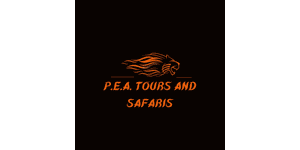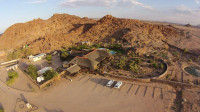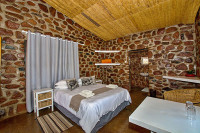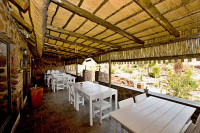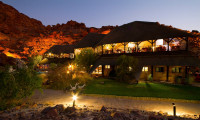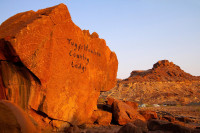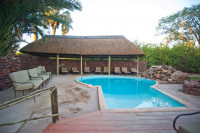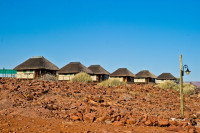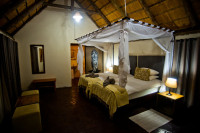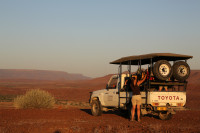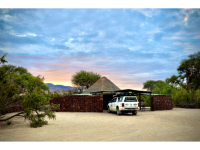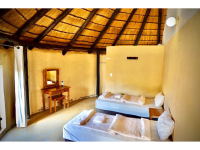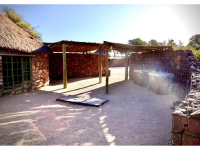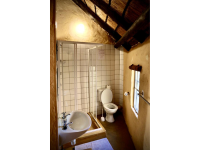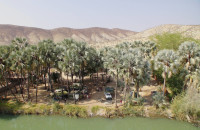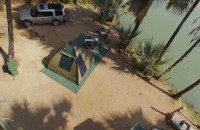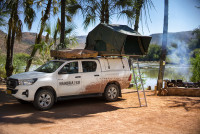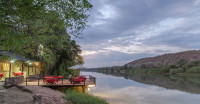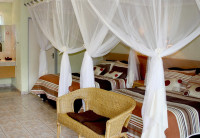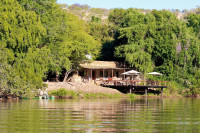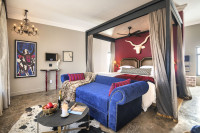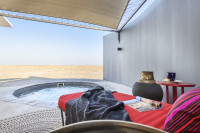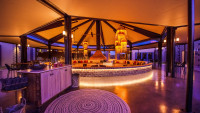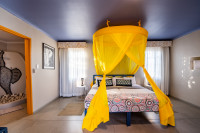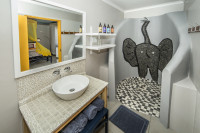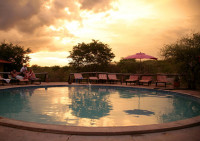
$8,250 pp (USD)
2 travelers on Start dateArrival
Arrival

Day 1
Brandberg Mountain
Brandberg Mountain
Your guide will meet you at the airport or accommodation establishment in Windhoek and head to Brandberg. You'll have a lunch stop along the way or upon arrival at Brandberg White-lady Lodge. This afternoon you will do a sundowner drive around the Brandberg area and explore the Ugab River. Various mammals and birds are found along the riverbed where they get food and water. Brandberg Mountain is the highest mountain in Namibia, measuring 2,573 m (8,442 ft.) at its peak. “Brandberg” is Afrikaans, Dutch, and German for burning mountain, which comes from its glowing color which is sometimes seen in the setting or rising sun. The local Damara people named the mountain “Dâures”, which also means 'burning mountain'. The area has quite fascinating plants as well, of the 357 species recorded in this area, 11 are endemic to Brandberg.
- Main Destination:
- Brandberg Mountain (Rock Art)
- Accommodation:
- Brandberg White Lady Lodge
- Meals & Drinks:

Day 2
Brandberg Mountain
Brandberg Mountain
You'll visit the White Lady Rock painting after breakfast. This is a half an hour hike through the Brandberg Mountain. There are about 1000 rock shelters around the Brandberg, and this was home to the San (Bushmen) people. Over 45,000 rock paintings have been found and of particular interest is the White Lady Rock painting. While some archeologists in the past concluded that the lady had elements of ancient Mediterranean origin, more recent scholars argue that the painting is from indigenous people with no European links. The white lady is a boy covered with white clay while undergoing an initiation ceremony. Others think it is a Shaman. Local guides will take us to the painting.
You'll be back for lunch at the lodge. In the afternoon, you will try your luck with desert-adapted elephants around this area.
- Main Destination:
- Brandberg Mountain (Rock Art)
- Accommodation:
- Brandberg White Lady Lodge
- Meals & Drinks:

Day 3
Damaraland
Damaraland
After morning breakfast, you will make your way to the Twyfelfontein area. You'll arrive at lunch and make your way to the Bushman Rock Engravings. This area was declared a UNESCO World Heritage Site in 2007 and consists of over 40,000 rock engravings done by the San people 2000 years ago. This is a 45-minute walk and is conducted by local guides. You will then visit some fascinating geological formations, the Organ Pipes and the Burnt Mountain. The Organ Pipes are tall angular columns of dolerite in a most unusual formation and the late afternoon light on the Burnt Mountain is worth seeing.
- Main Destination:
- Twyfelfontein (Rock Art)
- Accommodation:
- Twyfelfontein Country Lodge
- Meals & Drinks:

Day 4
Damaraland
Damaraland
You will explore the Aba-Huab and Huab ephemeral rivers in search of desert-adapted wildlife including elephants, black rhinos, oryx, springbok, and giraffes among others.
After lunch, you will visit the local Damara people, to learn how they foraged and hunted in the past. You have the opportunity to see tools, jewelry, and handmade crafts, as well as enjoy dancing, singing, and traditional games.
- Main Destination:
- Twyfelfontein (Rock Art)
- Accommodation:
- Twyfelfontein Country Lodge
- Meals & Drinks:

Day 5
Palmwag
Palmwag
Before heading north to your destination, you will visit the Petrified Forest after breakfast. This is a geological formation that happened 280 million years ago. Huge trees were carried by a river and buried here. Sand was deposited around them creating ideal conditions for the cells of the wood to be replaced by silica and thus become petrified. It is thought these trees are Dadoxylon arberi, the same tree responsible for coal fields in Europe. This is a half an hour's walk done by knowledgeable local guides.
You will then make your way to Palmwag and you should be there for lunch. Along the way, various wildlife can be spotted. One can either walk around the lodge area or relax at the swimming pool.
In the late afternoon, you will then go for a sundowner drive.
- Main Destination:
- Palmwag (Damaraland)
- Accommodation:
- Palmwag Lodge
- Meals & Drinks:

Day 6
Palmwag
Palmwag
This will be a very early morning start to search for the desert-adapted black rhino. You will be taken by local guides and rhino rangers. The Namib Desert is home to the last truly wild stronghold of black rhinos. This activity involves 4 x 4 driving in rugged terrain and walking safari to get to the rhinos if lucky. These mammals are not in a fenced area but in an open ecosystem. It is a joint venture of the Namibian Ministry of Environment and Tourism, the communities, Save Rhino Trust, and other Non-Governmental Organizations in the conservation of black rhinos. The program of Community-based Natural Resource Management seeks to empower people living in rural areas to manage and benefit from their natural resources.
This activity might take the whole day, however, there is still a possibility of a late afternoon sundowner drive in your own vehicle.
- Main Destination:
- Palmwag (Damaraland)
- Accommodation:
- Palmwag Lodge
- Meals & Drinks:
Day 7
Kaokoland (Hoarusib River)
Kaokoland (Hoarusib River)
After breakfast, you will make your way to Purros. You will explore the Hoanib River, which is 270km long and one of the 12 ephemeral rivers in Namibia. In addition to larger populations of many species of antelope found in the lower reaches of the Hoanib, there are also a large number of desert-adapted elephants, rhinos, giraffes and also several lion pride, and smaller predators. Among other wildlife in this area, you have chances with the desert-adapted lion. Only 150 of these animals are left in the wild. You will enjoy your lunch packs somewhere along the way and make it to your destination for the day.
- Main Destination:
- Purros (Town)
- Accommodation:
- Puros Bush Lodge & Camp
- Meals & Drinks:
Day 8
Kaokoland (Hoarusib River)
Kaokoland (Hoarusib River)
In the morning, you will explore the Hoarusib River, which is also rich in wildlife and birds. After lunch, you will visit the OvaHimba people and learn about their fascinating culture and way of life. They are semi-nomadic pastoralists with huge herds of cattle. This afternoon, you will learn about the intriguing traditional life of the OvaHimba people, including their dress, food, and craft. You will also learn about how the homestead is built, with holy fire at its heart (where all communication with ancestors takes place.
- Main Destination:
- Purros (Town)
- Accommodation:
- Puros Bush Lodge & Camp
- Meals & Drinks:

Day 9
Kaokoland (Epupa Falls)
Kaokoland (Epupa Falls)
You will continue your Wild West Namibia Expedition by moving far northwest of the country, Epupa Falls. You will be there around lunchtime. Late afternoon, you will visit the Epupa Falls on the Kunene River. The Falls are a series of cascades where the river drops a total of 60 meters over 1.5 km (a mile). It then separates into a multitude of channels and forms a myriad of rock pools. It is quite a breathtaking view as has richly colored rock walls mixed with wild fig and baobab trees, waving Makalani Palm trees spectacular sunsets, and perennially flowing waters. Bird watching is good with iconic species in the area including Rufous palm thrush, African fish eagle, and giant kingfisher, among others.
- Main Destination:
- Epupa Falls (Kaokoland)
- Accommodation:
- Omarunga Epupa-Falls Campsite
- Meals & Drinks:

Day 10
Kaokoland (Kunene River)
Kaokoland (Kunene River)
After breakfast, you will drive along the Kunene River. Nested in huge Makalani Palm trees, you'll enjoy the beauty, peace, and tranquility of this riverine habitat. You will arrive at lunch and embark on an afternoon boat cruise with the hope of seeing rare birds like the Cinderella Waxbill, Grey Kestrel, and Angolan Cave Chat among others. Various optional activities available include fishing, canoeing, and white-water rafting.
- Main Destination:
- Kunene River (Kaokoland)
- Accommodation:
- Kunene River Lodge
- Meals & Drinks:

Day 11
Etosha National Park North
Etosha National Park North
This is a driving day. After breakfast, you will continue exploring the Kunene River past a hydroelectric dam towards the small town of Ruacana. You will drive past a series of towns to get to your destination, Etosha North. These northern parts of Namibia are totally the opposite of Kaokoland as they are heavily populated. You will stop for lunch along the way. You'll get to experience the land of the Owambo people which has a total surface area of around 56 000km2. The land consists mainly of communal farming land and most of the inhabitants survive on subsistence farming. Various wetlands host several water birds. Your destination is the less visited part of the Etosha National Park, the northern Etosha.
- Main Destination:
- Eastern Etosha National Park
- Accommodation:
- Etosha King Nehale
- Meals & Drinks:

Day 12
Etosha National Park North
Etosha National Park North
You will explore this less-visited part of the Etosha National Park. You will do the morning and afternoon game drives and look for wildlife around waterholes. This part of the park has an open grassland and dense vegetation. Etosha has around 114 mammalian species and over 350 birds. Mammals found here include black and white rhinoceros, lion, leopard, cheetah, African elephant, Plains and Hartmann’s mountain zebra, Southern giraffe subs angolensis, eland, gemsbok, African wild cat, spotted and brown hyena among other animals.
- Main Destination:
- Eastern Etosha National Park
- Accommodation:
- Etosha King Nehale
- Meals & Drinks:

Day 13
Etosha National Park Southern Side
Etosha National Park Southern Side
After breakfast, you will drive from the northern part to the eastern and then make your way to the southern Etosha. This will be a full-day game drive in the park with a lunch stopover. Etosha National Park is semi-arid hence animals depend on contact springs, water level springs, artesian springs, and a couple of man-made waterholes for water. You will continue visiting waterholes and adding more to your animal list. You will be wrapping up your wild west Namibia adventure.
- Main Destination:
- Etosha National Park
- Accommodation:
- Etosha Safari Camp
- Meals & Drinks:
Day 14
Windhoek
Windhoek
You will depart to Windhoek where you may either stay for a night or catch a flight back home.
- Main Destination:
- No major destination visited
- Accommodation:
- No accommodation (End of tour)
- Meals & Drinks:

